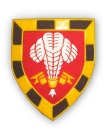

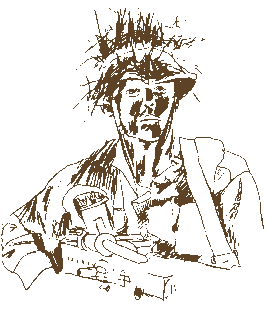
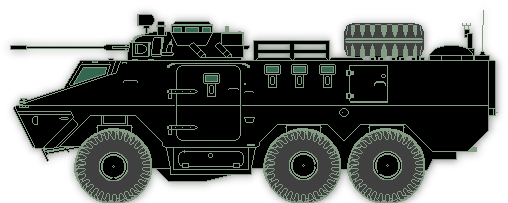
Call-up for Nasionale Diensplig
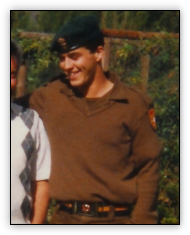 When I was called up to the 1st South African Infantry Battalion in Bloemfontein in 1988 I, like many other politically disinformed white South African youths, never really questioned the reasons behind the call-up. I definitely was not aware of the fact that Fidel Castro was maintaining tens of thousands of Cuban soldiers in Angola.
When I was called up to the 1st South African Infantry Battalion in Bloemfontein in 1988 I, like many other politically disinformed white South African youths, never really questioned the reasons behind the call-up. I definitely was not aware of the fact that Fidel Castro was maintaining tens of thousands of Cuban soldiers in Angola.
I'd gotten my first call-up papers in 1981 when I was still at school and because I was a British citizen I only needed to state that I was not willing to go and that was that. I still got called up every year afterwards until in 1985 a law was passed stating that foreign citizens living in the country for more than 10 years had to either take on the South African citizenship or leave the country.
We were not made to renounce our original citizenships and from then on carried dual nationalities, which I still have today. A lot of people decided to rather leave the country instead of taking on the South African citizenship as this new law meant that their sons would have to serve in the South African army too.
During the 1980's political instability within South Africa had reached it's peak and, as if this wasn't enough, there was a full-on war raging up on the borders of South West Africa and Angola. A war that few people were aware of, and one that is almost forgotten today. If I think back, I don't remember ever having spent a single moment worrying about what impact these factors would have on my life. I was too busy growing up!
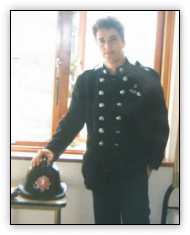 When I left school in 1984 I joined the Cape Town Fire Brigade where I spent the next 3 years doing civil service and having a party whilst I was at it. 10 years of civil service exempted one from doing National Service, but after 3 years I found that I wasn't really moving forward in life. When I was called up again for 1988, I decided to leave the brigade and do my service in the defence force. I was now 22 years old and ready for something new, and as I had already spent most of my life in uniform, be it at school or in the fire brigade, I didn't expect the army to be too great a hurdle.
When I left school in 1984 I joined the Cape Town Fire Brigade where I spent the next 3 years doing civil service and having a party whilst I was at it. 10 years of civil service exempted one from doing National Service, but after 3 years I found that I wasn't really moving forward in life. When I was called up again for 1988, I decided to leave the brigade and do my service in the defence force. I was now 22 years old and ready for something new, and as I had already spent most of my life in uniform, be it at school or in the fire brigade, I didn't expect the army to be too great a hurdle.
The fire brigade was fun, and I experienced a lot of crazy things whilst putting out fires in Cape Town, but I wanted more out of life and the only way to get ahead in South Africa at the time was to do my duty in the army. So it happened that I went to 1 SAI in Bloemfontein, South Africa's premiere mechanized infantry battalion. Being a few years older than the other guys who were mostly 18 and fresh out of school, and having spent 3 years in the fire brigade I was quite used to taking orders from rank. This would prove to be a great advantage for me.
Basic Training
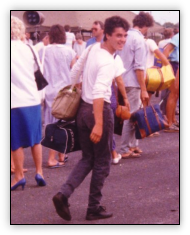 The military experience started on Tuesday the 2nd of February 1988 at Wingfield Airbase in Goodwood which was the assembly point for the 88 intake in Cape Town. Click here to view the pamphlet they handed out that day. After saying our farewells we were walked to the railway platform inside the base where we boarded the train to Bloemfontein in the Orange Free State.
The military experience started on Tuesday the 2nd of February 1988 at Wingfield Airbase in Goodwood which was the assembly point for the 88 intake in Cape Town. Click here to view the pamphlet they handed out that day. After saying our farewells we were walked to the railway platform inside the base where we boarded the train to Bloemfontein in the Orange Free State.
The train journey took about a day and a half and was a quite relaxing. We were six guys in the compartment, four english and two afrikaans, and I remember that one guy, his name was also James, was the son of a famous South African actor called Gordon Mulholland.
When we got to Bloemfontein, which is about 1000 Kms north of Cape Town, we were ordered to climb into the waiting SAMILs (South African Military trucks) and taken to Tempe, the military base that housed 1 South African Infantry Battalion, 1 Parachute Battalion, 1 Special Services Battalion and 3 Military Hospital. Once inside our unit's perimeter we were divided into the different platoons and taken to our bungalows. I was allocated to Oscar Company, platoon 13 and our bungalow was down by the main gate opposite those of Charlie Company. Our platoon Corporal was Corporal Cronje, and he was very relaxed in comparison to the Corporals in charge of the other platoons. Lucky for us. That evening we were taken up to the stores to get some kit and bedding and we then had to carry it back to our bungalows, which was about half a kilometer away!!
The next day we were taken down to a big hall at Tempe's sports grounds where we were subjected to a battery of medical tests. This was called documentation, and ended with my being classified as G1K1, physically and mentally fit for service. There were of course quite a few other types of classification groups, G3K3 meant not quite suitable for full service and these guys usually ended up with some easy function like working in the stores. G5K5 meant absolutely unfit for service, and one of the afrikaans guys from our platoon was classified G5K5 because it was found that he had never been to school. He was 25 years old and came from a farm in Gamtoos. Needless to say, he and all the other G5K5s were discharged and sent home immediately.
After classification we were again herded off, this time to the barbers where we had our hair cut. Having been a bit of a punk before I went into the army, the new regulation haircut looked really shite on me. The only thing that made me feel better was the fact that it looked pretty much just as shite on everyone else as well!! That evening we were herded up to the stores once again to be issued with our uniforms and other stuff, and by then it was dawning on all of us what it meant to be indoctrinated into the South African Military Machine
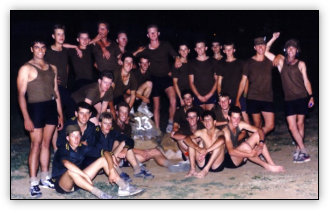
Basic training meant getting up at 5 am every morning. After a quick wash and shave, we were marched up to the mess for breakfast where we had to wait our turn before going in. Once inside we had to be really quick as the Corporals always shouted "hurry up and swallow your food! You can chew it later!" which I thought was ridiculous.
When I was a kid I had a real problem as far as eating was concerned and this was one of my bigger worries before coming to the army, but the food that they dished up was surprisingly good. One didn't get very much, but at least it was good. On the odd occasion each platoon had to do a chicken parade after breakfast, which meant that the whole platoon had to spread out in a straight line and move over the parade ground picking (like chickens do) every tiny bit of litter up that could be found. If it wasn't our turn to do a chicken parade, we had to rush back to our bungalows to get ready for inspection.
This was a pretty strict routine at first. Amongst other things, our beds had to be squared like a matchbox and this was usually done by pressing the corners between two shoe brushes until they were crisp and sharp. In addition to this, we had to brush the weave of our blankets from the middle outwards in order to make it look even sharper. If your bed didn't meet the set standards the Corporal would just dump the whole thing upside down, frame and all. When rank walked into the bungalow, someone (normally the person closest to the door) would shout "Staan op!!" (Stand up!) At which point everyone would jump to attention. Failure to do this was regarded as having a lack of respect and would earn everyone a round of PT generally termed as an "opfok" which meant to fuck us up, and came mostly in the form of push-ups or other strenuous physical training.
These were all exercises aimed at teaching everyone to work as a team. Often, if our guys weren't pushing 100% our Corporals would shout "Julle maaitjies wil nie saam werk nie!" (Your buddies don't want to work together) and this would lead to another round of PT for the whole platoon, so we quickly learned to work together. Much later this kind of training would save many a life, but in those first days of basic training it was a real strain doing anything that was right in the eyes of our instructors.
After breakfast and inspection we had to march around the parade ground for a few hours before breaking for tea. This was routine for the whole of Basics, and we were drilled so hard that I can still march perfectly today! This is one of the many impressions from my service in the SADF that have stuck with me up until the present day. They will probably remain with me forever! After tea we had different classes which were in tents set up around the base, and we were made to "hurry up and wait" through the rest of the day, learning to be a soldier. (Hurry up and wait meant always being hurried off somewhere, only to have to wait ages for the next thing to happen)
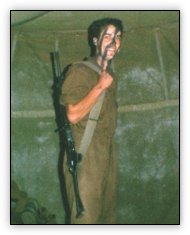 Within two weeks we were issued with our rifles, the R4, a 5.56 mm ARM which was based on the Israeli Galil (see equipment page) The day we were issued with the R4, the guys from the 1987 intake were busy handing in their's. They had just come down from the border where they had been subjected to some of the heaviest battles to date, and they looked it. These guys looked wild and we were ordered to stay well clear of them. It's obvious why. The stories they had to tell were enough to give us all the shits as they were involved in major battles at Tumpo a few days earlier, where quite a few 1 SAI guys were killed in action. The oumanne were in camp for a day or two before being sent on pass and during that time we heard a lot about the MiG menace that they were subjected to.
Within two weeks we were issued with our rifles, the R4, a 5.56 mm ARM which was based on the Israeli Galil (see equipment page) The day we were issued with the R4, the guys from the 1987 intake were busy handing in their's. They had just come down from the border where they had been subjected to some of the heaviest battles to date, and they looked it. These guys looked wild and we were ordered to stay well clear of them. It's obvious why. The stories they had to tell were enough to give us all the shits as they were involved in major battles at Tumpo a few days earlier, where quite a few 1 SAI guys were killed in action. The oumanne were in camp for a day or two before being sent on pass and during that time we heard a lot about the MiG menace that they were subjected to.
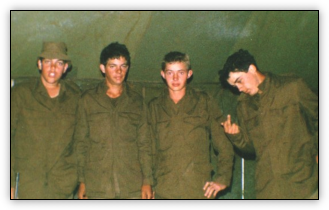 Once they were gone, basic training continued without further incident. We were now "married" to our rifles, and in order to get us used to the weight we did a lot of rifle PT which entailed holding the thing above your head for ages or holding it in outstretched arms until your arms fell off, or holding it at arm's length whilst turning the rifle in your hands. These exercises really made our arms ache, and one of the favorite opfoks after that was running around distant trees with your rifle above your head.
Once they were gone, basic training continued without further incident. We were now "married" to our rifles, and in order to get us used to the weight we did a lot of rifle PT which entailed holding the thing above your head for ages or holding it in outstretched arms until your arms fell off, or holding it at arm's length whilst turning the rifle in your hands. These exercises really made our arms ache, and one of the favorite opfoks after that was running around distant trees with your rifle above your head.
We were taught to leopard crawl with the gun and to do a battle manouevre termed "dash, down, roll, crawl, observe, fire". This is pretty much self explanatory and made us all extremely aggro, (aggressive) if you can imagine running, falling, rolling and crawling through muddy, stoney, thorny areas of bush for hours on end shouting tap tap (the imaginary loosing of two shots). This training was rough, but one army "spreekwoord" (motto) was "Harde opleiding spaar lewens" (tough training saves lives) and that was a fact!! Most important after a day of leopard crawling around in the mud (Bloem was experiencing a particularly heavy rainy season) was learning to strip and clean the gun in record times, even blindfolded. After a hard day's training some guys even took their guns under the showers with them. This was quite a sight indeed!
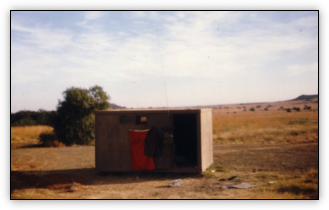 At regular intervals we visited the shooting range to learn how to shoot with our R4s and I always used to enjoy this whole day away from base. The rifle range was outside of Bloemfontein at a place called De Brug, a 250 000 hectare tract of land that was utilized by the SADF as a training ground. We would still spend many a day and night there.
At regular intervals we visited the shooting range to learn how to shoot with our R4s and I always used to enjoy this whole day away from base. The rifle range was outside of Bloemfontein at a place called De Brug, a 250 000 hectare tract of land that was utilized by the SADF as a training ground. We would still spend many a day and night there.
The rifle range consisted of mounds divided into 100 meter sections that went back to 1000 meters. Opfok at the rifle range meant running with an empty ammo crate up and down the course, and I guess everyone had a turn at doing this. The R4 was an amazing rifle, with almost no recoil at all, and we were subsequently taught to shoot standing, sitting, kneeling and lying at distances of 100 meters onwards. I was pretty good at shooting because when I was still at school we used to live on a farm and I did a lot of shooting in those days. I went on to earn my Skietbaaltjie, an award that we were allowed to sew onto our shirts to indicate that we were marksmen. This carried a certain amount of prestige with it of course. During our tea breaks at the shooting range we would remove the projectiles off bullets and pour loads of gunpowder down the many termite holes in the terrain. Once ignited, clouds of black smoke and sparks came shooting out of interconnected holes all around us. Boys will be boys!!
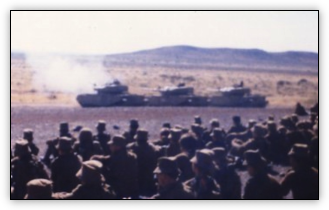 One particular day the whole battalion was trucked out to De Brug where we were all marched up a hill. Upon reaching the crest we saw to our excitement a whole lineup of the military's finest vehicles and weaponry. This was to be a display of firepower the likes of which we had never seen before. They fired off just about everything that could be fired from a Ratel, from the 20 mil to the 90 mil, and also a Milan missile. Then the Olifant tanks had their turn, and the G5 cannons, RPG 7 rocket launchers, mortars, grenade launchers, anti-personnel mines, machine guns, the whole palette! I had my camera with me and made some photos, the enlargements of which you can see on the Photographs page. That was spectacular indeed. Every target they fired on was reduced to smithereens in an instant. When the demonstration was over, I think that we all went away feeling very indestructible at that point.
One particular day the whole battalion was trucked out to De Brug where we were all marched up a hill. Upon reaching the crest we saw to our excitement a whole lineup of the military's finest vehicles and weaponry. This was to be a display of firepower the likes of which we had never seen before. They fired off just about everything that could be fired from a Ratel, from the 20 mil to the 90 mil, and also a Milan missile. Then the Olifant tanks had their turn, and the G5 cannons, RPG 7 rocket launchers, mortars, grenade launchers, anti-personnel mines, machine guns, the whole palette! I had my camera with me and made some photos, the enlargements of which you can see on the Photographs page. That was spectacular indeed. Every target they fired on was reduced to smithereens in an instant. When the demonstration was over, I think that we all went away feeling very indestructible at that point.
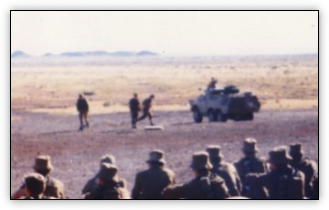 A funny incident worth noting here was the demonstration of large foam pads which one could apparently use for walking through a minefield. After showing us some Claymore anti-personnel mines, our instructors brought out these big pads and said that even the heaviest troopie could walk through a minefield on these things without being blasted and commenced to prove this by calling our fattest guy to try them out. They placed a dud mine underneath the pad and our fatty walked over it. To our surprise the dud went off with a pop and a small cloud of smoke! The whole Battalion burst out laughing and it really was a funny sight, but I had made a mental note not ever to end up in a situation where I'd have to rely on those things.
A funny incident worth noting here was the demonstration of large foam pads which one could apparently use for walking through a minefield. After showing us some Claymore anti-personnel mines, our instructors brought out these big pads and said that even the heaviest troopie could walk through a minefield on these things without being blasted and commenced to prove this by calling our fattest guy to try them out. They placed a dud mine underneath the pad and our fatty walked over it. To our surprise the dud went off with a pop and a small cloud of smoke! The whole Battalion burst out laughing and it really was a funny sight, but I had made a mental note not ever to end up in a situation where I'd have to rely on those things.
Back in base we continued to learn new skills. We regularly had fitness tests that entailed 30 km route marches, doing huge amounts of push-ups, sit-ups, pull-ups and running the 2,4 km with full kit in less than twelve minutes. I was quite proud of my physical condition and by the end of basics my record for the 2,4 was 9 minutes and 53 seconds. We went back to De Brug a few times after that magnificent display of firepower, learning "veldkuns" the art of surviving in the bush, camoflage and concealment, manouevring in formations, map reading and night navigation. We were also taught to scour the landscape spotting unnatural objects (like the enemy for example). Instead of scanning from left to right, like reading a book, we were told to scan from the right to the left as this way one would supposedly "see" more. The Corporals had hidden themselves and numerous other things in the bush and we had to locate as many things as possible. I remember that most of us failed dismally in this exercise as it was extremely difficult to spot anything at all, whichever way you looked!!
Towards the end of basics instructors visited us from other units to find out if anyone wanted to try out for selection to other units. These included Parabats our biggest rivals in Tempe, the Recces SA's elite reconnaissance unit, the mounted infantry, the dog handlers and all sorts of other interesting units. I can remember most of the parat ouens (the fittest under us) were opting for the Bats or the Recces, but I wanted to stay in 1 SAI. By now we were feeling pretty tough, and thinking about what we were going to do in second phase. A lot of my buddies were going for driving courses or gunner courses and I wanted to be a section leader. Up until now we hadn't seen the legendary Ratel (see equipment page) up close yet, but this was to change in second phase as I was elected to do JLs in Charlie Coy upon my return from pass.
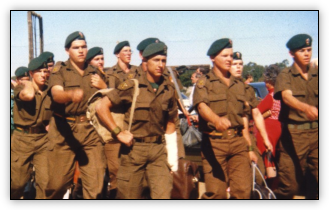 Thursday the 20th April 1988 marked the end of basics and we had a huge parade that our parents were also invited to. I was really happy that my parents came up from Cape Town to see me "passing out". This was a big occasion as it was also the first time that we were allowed to wear our unit's insignia. We were no longer roowers, we were now blougatte! After the parade we had our first pass and I kicked back and enjoyed civvie street as best I could. That week was great, but it passed so fast that I soon found myself in uniform and boarding a bus back up to Bloemfontein again.
Thursday the 20th April 1988 marked the end of basics and we had a huge parade that our parents were also invited to. I was really happy that my parents came up from Cape Town to see me "passing out". This was a big occasion as it was also the first time that we were allowed to wear our unit's insignia. We were no longer roowers, we were now blougatte! After the parade we had our first pass and I kicked back and enjoyed civvie street as best I could. That week was great, but it passed so fast that I soon found myself in uniform and boarding a bus back up to Bloemfontein again.
Second Phase JL's
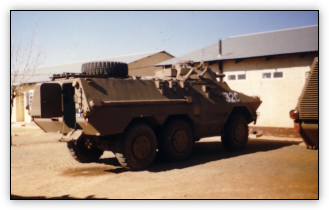 After that first pass, I was moved into Charlie Coy with a whole bunch of other guys from different Companies and from then on we were segregated from the rest of the Battalion. Most of us thought that the worst was over when basics was finished but if we thought basics was tough, boy were we in for a surprise. Second phase was to be 10 times tougher!
After that first pass, I was moved into Charlie Coy with a whole bunch of other guys from different Companies and from then on we were segregated from the rest of the Battalion. Most of us thought that the worst was over when basics was finished but if we thought basics was tough, boy were we in for a surprise. Second phase was to be 10 times tougher!
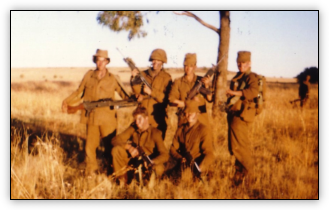 I had opted to do JLs the junior leadership course where, upon completing this course I would be awarded rank and be in charge of a Ratel with a section of men. At this stage I was at the peak of physical and mental fitness, the way the SADF had intended me to be, and nothing was going to stop me from achieving my own personal goal. (or so I thought)
I had opted to do JLs the junior leadership course where, upon completing this course I would be awarded rank and be in charge of a Ratel with a section of men. At this stage I was at the peak of physical and mental fitness, the way the SADF had intended me to be, and nothing was going to stop me from achieving my own personal goal. (or so I thought)
According to an extract out of my training manual, Second phase would last 10 weeks and training was set out as follows:
After that we were to learn urban counter insurgency and riot control.
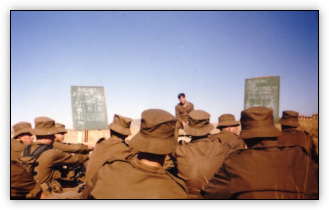 As second phase took off, we were subjected to long hard opfoks all the time. Our Company Sergeant was a mean mother if ever there was one. There were many myths about mean instructors in the army, but he was definitely the meanest I'd ever seen. He was a huge blonde guy, built like Mr Universe, and when he wasn't driving his silver Audi Quattro he was bromming around the base on his chopper motor-cycle. The sound of his bike always struck terror into our hearts when we heard it roaring in the distance because this often meant that he was on his way to give us an opfok. Besides the physical training, there were many interesting and exciting exercises which we took part in. As we were to be leaders, we were taught a lot about "low level command and control", how to take disciplinary action, how to handle under-achievers, or aggressive persons. We were taught Battalion structure, Ratel manoeuvres, section formations and using hand signals, camoflage and concealment, battle talk and mounted fire drills.
As second phase took off, we were subjected to long hard opfoks all the time. Our Company Sergeant was a mean mother if ever there was one. There were many myths about mean instructors in the army, but he was definitely the meanest I'd ever seen. He was a huge blonde guy, built like Mr Universe, and when he wasn't driving his silver Audi Quattro he was bromming around the base on his chopper motor-cycle. The sound of his bike always struck terror into our hearts when we heard it roaring in the distance because this often meant that he was on his way to give us an opfok. Besides the physical training, there were many interesting and exciting exercises which we took part in. As we were to be leaders, we were taught a lot about "low level command and control", how to take disciplinary action, how to handle under-achievers, or aggressive persons. We were taught Battalion structure, Ratel manoeuvres, section formations and using hand signals, camoflage and concealment, battle talk and mounted fire drills.
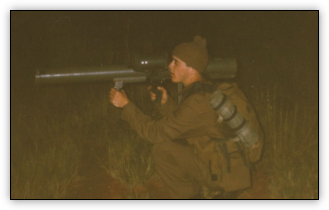 I still have my original notebook and it certainly makes interesting reading, especially the part on platoon weapons, my favorite subject. During this time we were taught how to operate the belt-fed LMG, the Beretta pump-action shotgun, the 60mm patmor (a light patrol mortar), the Meerkat, a 40mm multi-shot grenade launcher with occluded sight, the French 89mm rocket launcher (see equipment page), and last but by no means least, the Russian made RPG7. The latter was of course part of the huge caches of weapons captured by the SADF in successful cross-border operations, and I remember how interesting the ammo cases were as the writing on them was all in Russian.
I still have my original notebook and it certainly makes interesting reading, especially the part on platoon weapons, my favorite subject. During this time we were taught how to operate the belt-fed LMG, the Beretta pump-action shotgun, the 60mm patmor (a light patrol mortar), the Meerkat, a 40mm multi-shot grenade launcher with occluded sight, the French 89mm rocket launcher (see equipment page), and last but by no means least, the Russian made RPG7. The latter was of course part of the huge caches of weapons captured by the SADF in successful cross-border operations, and I remember how interesting the ammo cases were as the writing on them was all in Russian.
Second Phase VASBYT
Vasbyt can be defined as an "exercise aimed at testing endurance, initiative, teamwork, leadership and other qualities sought after in a person chosen to lead others. It is a walk over a given distance, along a planned route, along which candidates will be required to perform certain tasks under different forms of pressure". This definition comes from a newspaper clipping I kept from the time and hits the nail on the head. They certainly weren't joking!
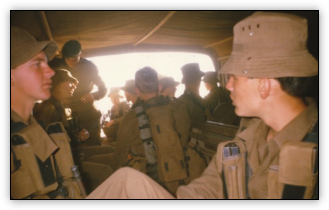 On the Sunday of the second week of second phase our company parade ground started filling up with Ratel tyres, tow-bars, oil drums and tar-poles in anticipation of Vasbyt. The moment we had all dreaded was to begin the very next day. On the morning of the 9th of May 1988, we the chosen few of 1 SAI Bn C-Coy Section Leader course of 88 set off on what would prove to be the ultimate opfok. This was the test that would bring out the character and the true colours of the men needed to keep the SADF the best fighting force in all Africa, and I was ready. We were divided into sections and were to do 90 kms in 3 days, carrying full kit and more from beginning to end.
On the Sunday of the second week of second phase our company parade ground started filling up with Ratel tyres, tow-bars, oil drums and tar-poles in anticipation of Vasbyt. The moment we had all dreaded was to begin the very next day. On the morning of the 9th of May 1988, we the chosen few of 1 SAI Bn C-Coy Section Leader course of 88 set off on what would prove to be the ultimate opfok. This was the test that would bring out the character and the true colours of the men needed to keep the SADF the best fighting force in all Africa, and I was ready. We were divided into sections and were to do 90 kms in 3 days, carrying full kit and more from beginning to end.
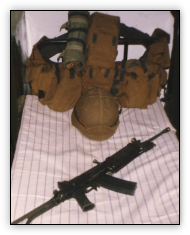 It was nearing winter which in Bloemfontein meant freezing cold at night and cooking hot during the day. I remember having reached the midday checkpoint of the first day with our group, after having marched the first half of the day with relative ease. At this checkpoint we were ordered to empty our bags of all our foodstuffs and drinks, which were subsequently confiscated. This was really bad because we all had our personal rations of condensed milk, Super-C sweets and isotonic energy drinks which we knew would be much needed for the 3 hard days that lay ahead. Of course, the confiscation of these things was all part of the mindfuck called Vasbyt. Having energy rations to back you up was a real advantage on a trip like this and Command knew it. If we were one day stuck in hostile territory and had to make it back to base on foot, we might have no rations at all so that's why they made us continue without.
It was nearing winter which in Bloemfontein meant freezing cold at night and cooking hot during the day. I remember having reached the midday checkpoint of the first day with our group, after having marched the first half of the day with relative ease. At this checkpoint we were ordered to empty our bags of all our foodstuffs and drinks, which were subsequently confiscated. This was really bad because we all had our personal rations of condensed milk, Super-C sweets and isotonic energy drinks which we knew would be much needed for the 3 hard days that lay ahead. Of course, the confiscation of these things was all part of the mindfuck called Vasbyt. Having energy rations to back you up was a real advantage on a trip like this and Command knew it. If we were one day stuck in hostile territory and had to make it back to base on foot, we might have no rations at all so that's why they made us continue without.
Still, confiscating our artificial energy makers did cause quite a blow to our morale as we all started wondering whether we'd make it without. To make things worse we were subsequently issued with a Ratel tyre and a tow-bar and told to move on. Although you may think that these objects aren't too heavy, try rolling a huge tyre over a distance of 15 kms! Things soon got out of hand. The tow-bar was bloody heavy and the tyre didn't stay on the road for long either. Soon everyone was moaning under the strain for the rest of that stretch. One thing that kept us going though was the promise of chalets, hot showers and hamburgers awaiting us at the end of the first day (which we all believed, silly us!), so on we trudged just concentrating on the guy's footsteps in front of us, maintaining a rythym and mentally switching off.
When we finally got to the campsite in the evening of the first day there was of course nothing of the promised luxury waiting for us and we soon realised that this was just another punch aimed to weed out those of weaker psyche amongst us. I can still clearly remember that first night, 140 guys in sleeping bags lying under the low trees on a half frozen hill outside Bloemfontein, dead tired wasn't the word! It was ice cold and the zip on my sleeping bag was broken, so I really wasn't impressed.
The next day is only a blank. I had taught myself to switch off when the going got tough, something that helped me cruise through basic training, and this was my own personal advantage. Day 2 must have been hell as I can't recall anything in particular. All I know is that we did another 30 kms, carrying our own equipment, the Ratel accessories and eventually also our weaker buddies, slowly but systematically towards camp 2. At the end of that day there were a whole lot less of our buddies there. Quite a few had "fallen" on the way, physically and morally broken and unable to continue. This meant that they would be unceremoniously dumped from the course, no rank for them!
The third and last day was a memorable one, for it was the last day of the Stap. The promise of seeing the end of this exercise just drove me on on on. At one stage when we had reached a river, we were made to strip down to our underwear and had to wrap our kit in our rainproof ponchos, after which we had to swim across the river pushing our kit in front of us. Those of us who hadn't packed their stuff properly ended up with wet, and therefore much heavier kit on the opposite riverbank. Then we had to dress quickly and move on. Just 12 more kms we were told. March, march, march, don't stop, don't think, just move forwards.
Towards the end of that day we had reached another camp where we were all allowed to rest up. It seemed that this was the end of the exercise and we were told to change into PT clothes and our kit was loaded up on SAMILs to be driven to Camp 3. Believing that we had finished the worst of the journey, we were then driven to another river, allocated some tar-poles and oil drums and told to create a float with which we had to swim ourselves and our kit another 5 kms downstream. If we thought this would be easy, it wasn't. The water was freezing cold and the floats were just big enough to carry one person. Besides that, they hardly floated at all! Anyway, 5 kms downstream we had finally reached the end of Vasbyt. I'd made it!
That night we still camped out and I remember freezing my coat off in my broken sleeping bag. After spending a long. miserable, sleepless night under a truck, the next day we were brought back to camp. By this time I wasn't feeling too well. I'd noticed that I was having difficulty breathing, and the sound of my lungs was very unnerving. I noticed that I was getting weaker and that night at roll-call I collapsed and was taken in a comatose state to 3 Military Hospital where I was diagnosed with double pneumonia. When I came to 36 hours later I was lying in an oxygen tent in the intensive care unit and told that I was lucky to be alive. This shook me up quite badly, and also put paid to my ambitions of becoming a section leader. What a stroke of bad luck! I'd just completed the mother of all Vasbyt Staps only to be taken down by a deadly bout of double pneumonia. After 10 days in hospital I was sent home on a long R and R which I really needed!
Upon my return to Platoon 1 of Charlie Company, the pace of our training had been stepped up quite a bit. There was a radical build up of Cuban and FAPLA troops close to the South West African border and things were really hotting up there. According to news reports, more Cubans were being shipped in and it seemed as though the enemy was poised for a massive strike against our forces. The SADF was also calling up thousands of campers to try and balance things out. We were to go to 61 Mech. and thereby form the main force to stand against the Cubans. Everyone was worried of course, but we were very ready. We had been through the toughest training possible and South Africa appeared to be the winning team in the war so we'd handle it we thought.
At the end of second phase I was called in to the Captains office and told that I would be moved to HQ platoon. As I had been away from the course for 20 days due to my pneumonia, I had missed out on a lot of important training and could therefore not qualify as a Section Leader. I was really disappointed. I'd managed the course very well up until my "sick phase" and after recovering, I bounced back into the training and was made to finish the course with all that it took, only to be told at the end that I hadn't made it! I found that very unfair, and I still get irritated when I think about it, but that's life in the army, for sure!
Lohatla and beyond
HQ platoon comprised of a lot of guys who hadn't made the grade during second phase, and when we went to Lohatla for third phase, I was allocated to a logistics group. I was to be a co-driver on a SAMIL supplying the fighting units out in the field. By this time I had resigned to my new task, and life in the army became decidedly easier!
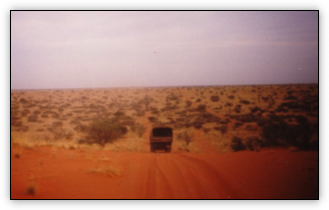 We spent the next few weeks driving around the Kalahari Desert in huge convoys practising desert driving, vehicle camoflage and doing countless "Visgraat" exercises under simulated MiG attack conditions. We were lived on RatPacks and weren't allowed to wash or shave or use deodorant. The reason for this, we were told, is because if you use soap, the enemy can smell you a mile away.
We spent the next few weeks driving around the Kalahari Desert in huge convoys practising desert driving, vehicle camoflage and doing countless "Visgraat" exercises under simulated MiG attack conditions. We were lived on RatPacks and weren't allowed to wash or shave or use deodorant. The reason for this, we were told, is because if you use soap, the enemy can smell you a mile away.
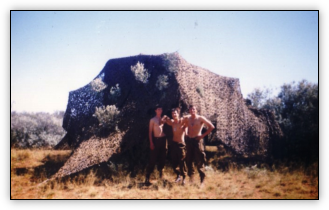 Friday evenings we returned to base where, after the Saturday morning Staal-Parade, we could basically relax for the rest of the weekend. Those days and nights in the wild African bush were amongst the most memorable I have ever spent in my 20 years in South Africa. The endless starry nights and the sounds and smells of the bushveld was an amazing experience, one I'll never forget.
Friday evenings we returned to base where, after the Saturday morning Staal-Parade, we could basically relax for the rest of the weekend. Those days and nights in the wild African bush were amongst the most memorable I have ever spent in my 20 years in South Africa. The endless starry nights and the sounds and smells of the bushveld was an amazing experience, one I'll never forget.
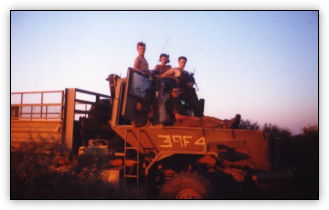 At Lohatla we took part in a number of spectacular mock-attacks with live ammunition, involving just about every active unit that was there at the time. It usually began with a number of jets flying overhead to bomb the objective (a poor little hill) Then the artillery opened up softening up the target some more. One by one the units moved in on the objective until it was the infantry's turn to move in and clean up. We were parked up on a hill overlooking the scene and I remember it being quite a radical sight with all the tracer fire bouncing around.
At Lohatla we took part in a number of spectacular mock-attacks with live ammunition, involving just about every active unit that was there at the time. It usually began with a number of jets flying overhead to bomb the objective (a poor little hill) Then the artillery opened up softening up the target some more. One by one the units moved in on the objective until it was the infantry's turn to move in and clean up. We were parked up on a hill overlooking the scene and I remember it being quite a radical sight with all the tracer fire bouncing around.
Things kind of moved on at a set pace until one particular weekend when a terrible incident occurred. Greame Lamb, one of the english guys I had done second phase with, was shot and killed by an afrikaans guy called Fourie. Graeme was now a Lance-Corporal and apparently he had given the guy one opfok too many. This would prove to be lethal because the afrikaans guy just cracked and shot him in the chest with an R4. I recall sitting in my tent on that Sunday evening when the shot went off. We all jumped up and ran to the ablution blocks where the Lance-Corporal was laying in a huge pool of blood. The projectile, upon exiting his back, had ripped a huge whole in his torso and there was nothing anyone could do to help him. He died within minutes of being shot. We were shocked, and this didn't do much towards breaking down animosity between Afrikaans and English guys. An animosity that has it's roots in the colonisation of South Africa by the British in the 19th century. RIP Graeme Lamb!
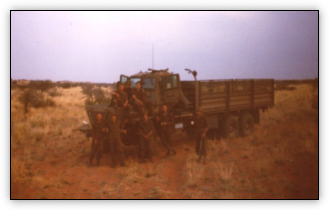 After that incident there was a major crack-down on us all as the MPs searched our tents for ammunition. Because we were doing a lot of live-ammo exercises on Lohatla at the time, many of the guys took to stealing ammunition afterwards, for whatever reason. Whoever was found in possession was in big trouble. After Lohatla we were trucked back to Bloemfontein where we would go on one last pass before going up to the border.
After that incident there was a major crack-down on us all as the MPs searched our tents for ammunition. Because we were doing a lot of live-ammo exercises on Lohatla at the time, many of the guys took to stealing ammunition afterwards, for whatever reason. Whoever was found in possession was in big trouble. After Lohatla we were trucked back to Bloemfontein where we would go on one last pass before going up to the border.
Upon arriving at base I was again called to the HQ where I was informed that I had been transferred to Western Province Command and I would be leaving Bloem before the end of the week. This was something I had been more or less expecting because my first son Timothy was born during basics and his mother had been trying relentlessly to get me transferred to Cape Town. In the end she had gotten it through.
The rest of my service was spent without much incident, besides having to spend one night in DB, but for personal reasons I won't go into that. I was stationed with the Wynberg Military Police until I was finally discharged in December 1989, 22 months after entering military service. By this time the war was over, the Cubans were pulling out of Angola, as were the South Africans, and South West Africa was on it's way to becoming Namibia and inevitably South Africa was on it's way to democracy.
Click here to view James Dekker's photos in the photo gallery
